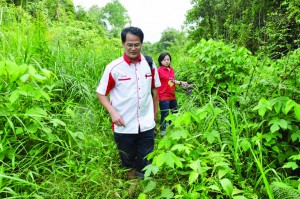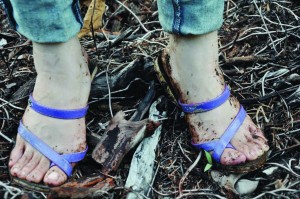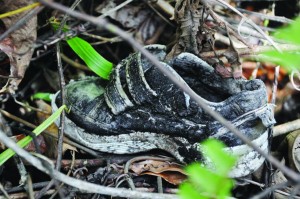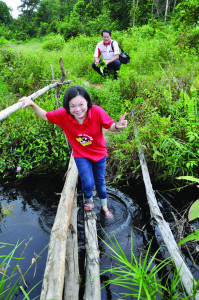On an early February morning this year, Dudong ADUN Yap Hoi Liong and Sibu DAP member Alice Lau took a walk down a path less travelled, literally. They were trekking through a ‘road’ travelled daily by students from Sungai Pak longhouse to their schools. Read on for what most Sarawak folks have to go through every day.
Jungle Path
In the course of their journey, the more they walked the more painful and angry they felt. “Why do the long house children still have to walk in this kind of roads in this day and age? Where’s the so called ‘upgraded roads?’” Yap complained.
The local councils have claimed that the roads have been upgraded for the longhouse residents
In the span of the two kilometres journey, they had not only walked in mud-filled and waist-high bush paths, the paths were also uneven and dotted with sharp stones and branches. “There are also the hills and burial sites to accompany us. The drains are not cleared and is covered with grasses,” Alice pointed out.
“This road from the Sungai Pak longhouse to the Sungai Pak national primary school is the same one travelled by the long house residents for the last 30 over years. The long house has about 20 students travelling on this road daily to go to and forth from the Sungai Pak national primary school,” Yap explained.
“In the 21st century, students in Sarawak still have to travel in such kind of roads to school daily,” Yap pointed out. Sungai Pak is only about 78 kilometres from Sibu
“We can’t even call this a village road. It should be called a rubber estate path; maybe more like a jungle path,” he mocked.
“The tough part is, the students have to leave the long house by 4.30 am every morning and walk for about one hour and 45 minutes before reaching their school. And walk back the same path home,” Yap continued.
“According to the school headmaster, after travelling three kilometres through the jungle-like walk path, the students are usually exhausted when they reached the school. Many drop out of school as a result of the dislike of the travelling.”
Soaking Up the Mud
 For those who take this long trek every school day, after a one and half hour tiring walk, they will first head to a specially prepared room in the school to clean up their mud-soak shoes and uniform.
For those who take this long trek every school day, after a one and half hour tiring walk, they will first head to a specially prepared room in the school to clean up their mud-soak shoes and uniform.
In the Sungai Pak area, there are four longhouses namely Rh Sandom ak jang, Rh Sylvester Ingon, Rh. Janang, Rh. Awieng. There are 95 households here, with a total of 20 school going children. These children usually set out in groups of five each morning to school, with a parent leading them.
Alice, who accompanied Yap on the journey, had blisters, bruises and wounds on both her feet that lasted a few days after the experience. “However, the hurt doesn’t compare to what the students have to go through every day,” she said teary-eyed.
Alice said, “In the past when I passed by here, I thought I saw what look like a jungle. After walking through this pathway I understand the children’s suffering.”
Decades of Neglect
“BN’s years of neglect of the natives are visible for anyone to see. After going through this journey, I am indignant for their children. After 49 years of ‘progress’ and ‘development’ in Malaysia, why do Sarawak children have to suffer such appalling conditions?” Yap said with distress.
“BN has been the administering Dudong since the 1970s; how do they account for themselves? If any BN MPs or ADUNs had travelled on such pathways, they will definitely take action for the people. But have they do it before?,” Alice lamented.
“Having to walk through such pathways everyday is not only frightening for the children; even for the adults it’s not safe.”
“It’s a demoralising situation; if they don’t walk through that pathway, the children can’t get education, but then they have to face the long dark walk and the thorns,” she sighed.
“And then there’s the heavy school bags they have to lug around. I would be discouraged from going to school if I were them, too. It’s a tiring journey for the adults, what more for the children,” she lamented.
She saw a glimmer of good in that, even though it’s small. “I admired the long house folks for their communal spirit in looking after each other’s children. They take turns to accompany the children on the walk to school every day.”
After personally going through what the native children experienced every day, Yap is determined to fight for change. “I will be querying the district council on the status of the roads that was supposed to have been paved by them.”
 “When I mentioned about the bad road conditions in Dudong in the state assembly (DUN), the BN representatives shouted back saying there is already a plan to build roads here in my area previously. I wondered where has it gone to?”
“When I mentioned about the bad road conditions in Dudong in the state assembly (DUN), the BN representatives shouted back saying there is already a plan to build roads here in my area previously. I wondered where has it gone to?”
“After walking through this pathway myself, I realised it’s just empty talk by the BN government. My eyes don’t lie,” he sneered.
“In order for the long house folks to go to town, they have to walk through this same pathway to the nearest bus stop near the school.”
“On our journey back from the track, our four-wheel drive (4WDs) vehicle broke down and couldn’t even get up the slope from the long houses. Finally we had to ask the locals’ assistance by using their 4WDs to help us out,” he mentioned.
Walking Barefoot
 On that day I only wore sandals for the walk, and what a mistake. I thought it was a paved road, easy on the feet. Then I realized I couldn’t get very far in these thorn-pricking and bush-filled pathways.
On that day I only wore sandals for the walk, and what a mistake. I thought it was a paved road, easy on the feet. Then I realized I couldn’t get very far in these thorn-pricking and bush-filled pathways.
If I even attempt to take a big stride, my foot will sink into the mud and it will be a difficult to take both my foot and sandals out. In the end, I decided to walk barefoot.
Big mistake for me! I had to suffer the thorns and scrubs underneath. This was my first time taking such a long walk in such painful condition. Ouch and agghs all the way!
It’s very dark in the morning; there’s only the moonlight to lit the way. If I were a mother, I would be worried for the children’s lives. During the journey, I stepped on and almost broke a wooden stick lined up as a small bridge across a stream along the pathway.
As if God was confirming we were on the right ‘jungle path’ as the one travelled by the students, we found a pair of abandoned mud filled school shoes along the journey. If I was their parents how would I feel for the children? They have to go through this painful conditions, every day?
 My thoughts wondered about those mud-soaked shoes: Did the children cast it away due to carelessness or having worn it out, or were they running away from something?
My thoughts wondered about those mud-soaked shoes: Did the children cast it away due to carelessness or having worn it out, or were they running away from something?
According to the locals, during the rainy season this pathway will be half-flooded. On our trek, we saw three good-sized streams flowing along the pathways.
During normal days the mud-filled paths is already a challenge for the adults to travel in. If it rains in the morning, this is like a sea; it’s dangerous. How do the children travel on them? By – Alice Lau




